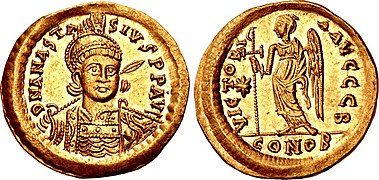Hellenic WorldPeloponneseSeleucid EmpireAll coins are tetradrachms unless mentioned otherwise.
Seleukos I Nikator, Susa (Portrait with panther's skin helmet, bull's ear and horn/Nike crowning trophy). [3] Antiochos I Soter, Ai-Khanoum (Portrait/Horned and deified horse of Seleukos). [4] Antiochos II Theos, Kyme (Portrait/Herakles holding mace). [5] Seleukos II Kallinikos, Antioch (Portrait/Apollo holding arrow). [6] Antiochos Hierax, Lampsakos (Portrait/Apollo holding arrow). [7] Antiochos III the Great, Antioch (Portrait/Apollo holding arrow). [9] Seleukos IV Philopator, possibly at Damaskos (Portrait/Apollo holding arrow). [10] Antiochos the Child, son of Seleukos IV, Antioch on the Orontes (Portrait/Apollo holding arrow). [11]Antiochos IV Epiphanes, Antioch in Persis (Portrait/Apollo holding arrow). [12] Antiochos IV Epiphanes, Antioch on the Orontes, 168-164 BC (Head of Zeus/Zeus Nikephoros). [13] Drachm of Timarchos (usurper), Ekbatana [14]Alexander I Balas, Syrian mint (Portrait/Zeus Nikephoros). [15] Alexander I Balas, with Kleopatra Thea, Ake, c.150 BC (Portraits/Zeus Nikephoros). [16] Antiochos VI Dionysos, Apameia on the Orontes (Radiate portrait/Dioskouroi within wreath). [17] Antiochos IX Kyzikenos, Antioch on the Orontes (Portrait/Athena holding Nike). [18] Antiochos XIII Asiatikos, Antioch on the Orontes (Portrait/Zeus Nikephoros). [19] Kingdom of MacedonAll coins struck at Aigai unless mentioned otherwise.
Carthage
Quarter shekel, possibly Spain (Hannibal as young Melqart/war elephant). [31] Roman RepublicOrdered by RRC number.
206-200 BC, Q. Lutatius Catulus or Cerco (Roma/Dioscuri). 169-158 BC, Furius Purpureo (Roma/Luna in chariot, murex above). 146 BC, C. Antestius (Roma, puppy behind/Dioscuri). 145 BC, M. Junius Silanus (Roma, ass's head behind/Dioscuri). 137 BC, Ti. Veturius (Mars/Oath scene). [32]136 BC, C. Servilius (Roma/ Pulex Geminus fighting as the Dioscuri). [33]131 BC, M. Opimius (Roma, tripod behind/Apollo in biga). 129 BC, Sextus Julius Caesar (Roma, anchor behind/Venus in biga, crowned by Cupid). 129 BC, Q. Marcius Philippus (Roma/Horseman, Macedonian helmet behind). 126 BC, Gaius Cassius Longinus (Roma, voting urn behind/ Libertas with pileus). [34]125 BC, C. Caecilius Metellus Caprarius (Roma/Triumph of Lucius Metellus in 251). [35]125 BC, M. Porcius Laeca (Roma/ Libertas in quadriga, holding pileus and crowned by Victory). 120 BC, M. Furius Philus. 113-112 BC, L. Manlius Torquatus (Roma, torque as border/Warrior on horseback). 109-108 BC, Mn. Aquillius ( Sol/ Luna in biga). Q. Lutatius Cerco, 109-108 BC. Mn. Fonteius, 108-107 BC. Mn. Fonteius, 108-107 BC. A. Manlius Q.f. Sergianus, 118-107 BC. L. Memmius Galeria, 106 BC. Q. Minucius Thermus, 103 BC. 102 BC, L. Cassius Caecianus (Ceres/yoke of Oxen). [36]101 BC, Gaius Fundanius (Roma/ Marius and his son in triumphal chariot). c.100 BC, M. Servilius (Roma/Pulex Geminus duelling). [37]C. Publicius Malleolus, 96 BC. 91 BC, D. Junius Silanus. 91 BC, D. Junius Silanus. 84 BC, P. Furius Crassipes. 82 BC, Sulla & L. Manlius Torquatus. 82-80 BC, , C. Servilius Vatia (Apollo, lituus behind/Pulex Geminus fighting). [38]80 BC, C. Poblicius (Roma/ Hercules strangling the Nemean Lion). 80 BC, A. Manlius (Roma/statue of Sulla). 79 BC, C. Naevius Balbus (Venus/Victory in triga). 75 BC, Lucius Cassius Longinus (Liber/Libera). 76 BC, L. Farsuleius Mensor. 82 BC, L. Manlius Torquatus. 63 BC, L. Cassius Longinus (Vesta/voter casting vote). 63 BC, L. Furius Brocchus. 57 BC, M. Nonius Sufenas. 82-80 BC, , C. Servilius (Flora, lituus behind/Pulex Geminus fighting). [39]56 BC, C. Memmius (Ceres/trophy and captive). Q. Cassius Longinus, 55 BC (Libertas/Temple of Vesta). 55 BC, P. Fonteius Capito ( Mars/Warrior on horseback, soldiers below). 55 BC, P. Fonteius Capito ( Concordia/ Villa Publica). 54 BC, Marcus Junius Brutus (Libertas/Lucius Brutus with lictors). 49 BC, Cn. Nerius (Saturn/Aquila with standards). 47 BC, Lucius Plautius Plancus ( Medusa/ Nicomachus of Thebes' Victory). C. Considius Paetus, 46 BC. Cn. Pompey & M. Poblicius, 46-45 BC. C. Julius Caesar and L. Munatius Plancus, 45 BC. Gaius Julius Caesar, 44 BC. Gaius Julius Caesar, 44 BC. L. Cestius and C. Norbanus, 43 BC. C. Cassius Longinus, 42 BC (Libertas/tripod). Roman EmpireOrdered by RIC number.
19-18 BC, the Clipeus Virtutis within oak-wreath. 19-18 BC, the Clipeus Virtutis between standard and aquila. 10 BC, with bull butting (symbol of Caesar's legions). 28 BC, with a crocodile (allegory of Egypt). 19 BC, P. Petronius Turpilianus (Augustus/Winged siren with flutes). 19 BC, L. Aquillius Florus (Sol/Chariot with modius). 19 BC, L. Aquillius Florus (Augustus/Flower). 17 BC, M. Sanquinius ( Caesar, with Comet above/Herald of the Ludi Saeculares). [40] Later emperors
AD 134-138, allegory of Egypt. AD 134-138, allegory of Africa. AD 134-138, allegory of Alexandria. AD 134-138, allegory of Asia. AD 134-138, allegory of Germania. AD 134-138, allegory of Hispania. AD 134-138, allegory of Italia. AD 134-138, allegory of Nilus. AD 139, with Aurelius Caesar. [41]AD 140-144, showing the betrothal of Aurelius and Faustina in 139. [42]AD 166, Victoria with shield inscribed VIC PAR. [43]AD 161-180, pile of German trophies. [44]AD 16, medallion, Jupiter between Aurelius and Verus. [45]AD 202, Septimius/Geta (right), Julia Domna (centre), Caracalla (left). [46] Byzantine EmpireReferences
- ^ Hoover, Handbook of Coins of the Peloponnesos, p. 58.
- ^ Hoover, Handbook of Coins of the Peloponnesos, p. 161.
- ^ Hoover, Handbook of Syrian Coins, p. 9.
- ^ Hoover, Handbook of Syrian Coins, pp. 30-31.
- ^ Hoover, Handbook of Syrian Coins, pp. 48-49.
- ^ Hoover, Handbook of Syrian Coins, p. 61.
- ^ Hoover, Handbook of Syrian Coins, pp. 80.
- ^ Hoover, Handbook of Syrian Coins, pp. 84-85.
- ^ Hoover, Handbook of Syrian Coins, pp. 95-96.
- ^ Hoover, Handbook of Syrian Coins, p. 118.
- ^ Hoover, Handbook of Syrian Coins, p. 124.
- ^ Hoover, Handbook of Syrian Coins, p. 127.
- ^ Hoover, Handbook of Syrian Coins, pp. 128-129.
- ^ Hoover, Handbook of Syrian Coins, p. 152.
- ^ Hoover, Handbook of Syrian Coins, p. 175.
- ^ Hoover, Handbook of Syrian Coins, pp. 176-177.
- ^ Hoover, Handbook of Syrian Coins, p. 203.
- ^ Hoover, Handbook of Syrian Coins, pp. 250-251.
- ^ Hoover, Handbook of Syrian Coins, p. 279.
- ^ Hoover, Handbook of Coins of Macedon, Part I, p. 118.
- ^ Hoover, Handbook of Coins of Macedon, Part I, p. 277.
- ^ Hoover, Handbook of Coins of Macedon, Part I, pp. 285, 286.
- ^ Hoover, Handbook of Coins of Macedon, Part I, p. 288.
- ^ Hoover, Handbook of Coins of Macedon, Part I, p. 291.
- ^ Hoover, Handbook of Coins of Macedon, Part I, p. 295.
- ^ Hoover, Handbook of Coins of Macedon, Part I, p. 296.
- ^ Hoover, Handbook of Coins of Macedon, Part I, p. 312.
- ^ Hoover, Handbook of Coins of Macedon, Part I, p. 380.
- ^ Hoover, Handbook of Coins of Macedon, Part I, p. 389.
- ^ Hoover, Handbook of Coins of Macedon, Part I, p. 390.
- ^ Sylloge Nummorum Graecorum, Great Britain, Volume IX, British Museum, Part 2: Spain, London, 2002, n° 102.
- ^ Crawford, Roman Republican Coinage, pp. 266, 267.
- ^ Crawford, Roman Republican Coinage, pp. 270, 271.
- ^ Crawford, Roman Republican Coinage, pp. 316, 317.
- ^ Crawford, Roman Republican Coinage, pp. 292, 293.
- ^ Crawford, Roman Republican Coinage, pp. 325, 326.
- ^ Crawford, Roman Republican Coinage, p. 328.
- ^ Crawford, Roman Republican Coinage, p. 388.
- ^ Crawford, Roman Republican Coinage, p. 447.
- ^ Sutherland, Roman Imperial Coinage, vol. I, p. 66.
- ^ Mattingly & Sydenham, Roman Imperial Coinage, vol. III, p. 77.
- ^ Mattingly & Sydenham, Roman Imperial Coinage, vol. III, p. 108.
- ^ Mattingly & Sydenham, Roman Imperial Coinage, vol. III, p. 226.
- ^ Mattingly & Sydenham, Roman Imperial Coinage, vol. III, p. 241.
- ^ Gnecchi, Medaglioni Romani, p. 33.
- ^ Mattingly & Sydenham, Roman Imperial Coinage, vol. IV, part I, p. 115.
|

![Stater of Sikyon, 335-330 BC, with a Chimera.[1]](https://upload.wikimedia.org/wikipedia/commons/thumb/8/88/Sikyon%2C_stater%2C_335-330_BC%2C_HGC_5-201.jpg/367px-Sikyon%2C_stater%2C_335-330_BC%2C_HGC_5-201.jpg)
![Triobol of Argos, 270-250 BC (Wolf/A with eagle on harpa below).[2]](https://upload.wikimedia.org/wikipedia/commons/thumb/6/65/Argos%2C_Triobol%2C_c.270-250_BC%2C_HGC_5-670.jpg/365px-Argos%2C_Triobol%2C_c.270-250_BC%2C_HGC_5-670.jpg)
![Seleukos I Nikator, Susa (Portrait with panther's skin helmet, bull's ear and horn/Nike crowning trophy).[3]](https://upload.wikimedia.org/wikipedia/commons/thumb/5/50/Seleukos_I_Nikator%2C_tetradrachm%2C_312-281_BC%2C_HGC_9-20.jpg/363px-Seleukos_I_Nikator%2C_tetradrachm%2C_312-281_BC%2C_HGC_9-20.jpg)
![Antiochos I Soter, Ai-Khanoum (Portrait/Horned and deified horse of Seleukos).[4]](https://upload.wikimedia.org/wikipedia/commons/thumb/6/64/Antiochos_I_Soter%2C_Tetradrachm%2C_281-261_BC%2C_HGC_9-132.jpg/392px-Antiochos_I_Soter%2C_Tetradrachm%2C_281-261_BC%2C_HGC_9-132.jpg)
![Antiochos II Theos, Kyme (Portrait/Herakles holding mace).[5]](https://upload.wikimedia.org/wikipedia/commons/thumb/3/38/Antiochos_II_Theos%2C_Tetradrachm%2C_261-246_BC%2C_HGC_9-241c.jpg/358px-Antiochos_II_Theos%2C_Tetradrachm%2C_261-246_BC%2C_HGC_9-241c.jpg)
![Seleukos II Kallinikos, Antioch (Portrait/Apollo holding arrow).[6]](https://upload.wikimedia.org/wikipedia/commons/thumb/9/9a/Seleukos_II_Kallinikos%2C_Tetradrachm%2C_246-225_BC%2C_HGC_9-303p.jpg/372px-Seleukos_II_Kallinikos%2C_Tetradrachm%2C_246-225_BC%2C_HGC_9-303p.jpg)
![Antiochos Hierax, Lampsakos (Portrait/Apollo holding arrow).[7]](https://upload.wikimedia.org/wikipedia/commons/thumb/e/e4/Antiochos_Hierax%2C_Tetradrachm%2C_c.242-227_BC%2C_HGC_9-403c.jpg/349px-Antiochos_Hierax%2C_Tetradrachm%2C_c.242-227_BC%2C_HGC_9-403c.jpg)
![Seleukos III Keraunos, Antioch on the Orontes (Portrait/Apollo holding arrow).[8]](https://upload.wikimedia.org/wikipedia/commons/thumb/9/90/Seleukos_III_Keraunos%2C_Tetradrachm%2C_226-223_BC%2C_HGC_3-414c.jpg/361px-Seleukos_III_Keraunos%2C_Tetradrachm%2C_226-223_BC%2C_HGC_3-414c.jpg)
![Antiochos III the Great, Antioch (Portrait/Apollo holding arrow).[9]](https://upload.wikimedia.org/wikipedia/commons/thumb/a/a9/Antiochos_III_the_Great%2C_Tetradrachm%2C_222-187_BC%2C_HGC_9-447u.jpg/375px-Antiochos_III_the_Great%2C_Tetradrachm%2C_222-187_BC%2C_HGC_9-447u.jpg)
![Seleukos IV Philopator, possibly at Damaskos (Portrait/Apollo holding arrow).[10]](https://upload.wikimedia.org/wikipedia/commons/thumb/7/73/Seleukos_IV_Philopator%2C_Tetradrachm%2C_187-175_BC%2C_HGC_9-580g.jpg/353px-Seleukos_IV_Philopator%2C_Tetradrachm%2C_187-175_BC%2C_HGC_9-580g.jpg)
![Antiochos the Child, son of Seleukos IV, Antioch on the Orontes (Portrait/Apollo holding arrow).[11]](https://upload.wikimedia.org/wikipedia/commons/thumb/9/92/Antiochos_the_Child%2C_son_of_Seleukos_IV%2C_Tetradrachm%2C_175_BC%2C_HGC_9-610b.jpg/365px-Antiochos_the_Child%2C_son_of_Seleukos_IV%2C_Tetradrachm%2C_175_BC%2C_HGC_9-610b.jpg)
![Antiochos IV Epiphanes, Antioch in Persis (Portrait/Apollo holding arrow).[12]](https://upload.wikimedia.org/wikipedia/commons/thumb/b/b2/Antiochos_IV_Epiphanes%2C_Tetradrachm%2C_175-164_BC%2C_HGC_9-615l.jpg/359px-Antiochos_IV_Epiphanes%2C_Tetradrachm%2C_175-164_BC%2C_HGC_9-615l.jpg)
![Antiochos IV Epiphanes, Antioch on the Orontes, 168-164 BC (Head of Zeus/Zeus Nikephoros).[13]](https://upload.wikimedia.org/wikipedia/commons/thumb/2/2e/Antiochos_IV_Epiphanes%2C_Tetradrachm%2C_175-164_BC%2C_HGC_9-620a.jpg/387px-Antiochos_IV_Epiphanes%2C_Tetradrachm%2C_175-164_BC%2C_HGC_9-620a.jpg)
![Drachm of Timarchos (usurper), Ekbatana[14]](https://upload.wikimedia.org/wikipedia/commons/thumb/c/c5/Timarchos%2C_Drachm%2C_164-161_BC%2C_HGC_9-762.jpg/342px-Timarchos%2C_Drachm%2C_164-161_BC%2C_HGC_9-762.jpg)
![Alexander I Balas, Syrian mint (Portrait/Zeus Nikephoros).[15]](https://upload.wikimedia.org/wikipedia/commons/thumb/1/18/Alexander_I_Balas%2C_Tetradrachm%2C_152-145_BC%2C_HGC_9-875d.jpg/389px-Alexander_I_Balas%2C_Tetradrachm%2C_152-145_BC%2C_HGC_9-875d.jpg)
![Alexander I Balas, with Kleopatra Thea, Ake, c.150 BC (Portraits/Zeus Nikephoros).[16]](https://upload.wikimedia.org/wikipedia/commons/thumb/5/50/Alexander_I_Balas%2C_with_Kleopatra_Thea%2C_Tetradrachm%2C_c.150_BC%2C_HGC_9-880.jpg/376px-Alexander_I_Balas%2C_with_Kleopatra_Thea%2C_Tetradrachm%2C_c.150_BC%2C_HGC_9-880.jpg)
![Antiochos VI Dionysos, Apameia on the Orontes (Radiate portrait/Dioskouroi within wreath).[17]](https://upload.wikimedia.org/wikipedia/commons/thumb/c/ce/Antiochos_VI_Dionysos%2C_Tetradrachm%2C_144-143_BC%2C_HGC_9-1032.jpg/353px-Antiochos_VI_Dionysos%2C_Tetradrachm%2C_144-143_BC%2C_HGC_9-1032.jpg)
![Antiochos IX Kyzikenos, Antioch on the Orontes (Portrait/Athena holding Nike).[18]](https://upload.wikimedia.org/wikipedia/commons/thumb/2/24/Antiochos_IX_Kyzikenos%2C_Tetradrachm%2C_110-109_BC%2C_HGC_3-1228i.jpg/365px-Antiochos_IX_Kyzikenos%2C_Tetradrachm%2C_110-109_BC%2C_HGC_3-1228i.jpg)
![Antiochos XIII Asiatikos, Antioch on the Orontes (Portrait/Zeus Nikephoros).[19]](https://upload.wikimedia.org/wikipedia/commons/thumb/9/9a/Antiochos_XIII_Asiatikos%2C_Tetradrachm%2C_69-64_BC%2C_HGC_9-1340.jpg/378px-Antiochos_XIII_Asiatikos%2C_Tetradrachm%2C_69-64_BC%2C_HGC_9-1340.jpg)
![Oktadrachm of the Bisaltai (Horseman leading horse/quadripartite incuse square).[20]](https://upload.wikimedia.org/wikipedia/commons/thumb/8/84/Thraco-Macedonian_Tribes%2C_Bisaltai%2C_Oktadrachm%2C_c.475-465_BC%2C_HGC_3-I-274.jpg/387px-Thraco-Macedonian_Tribes%2C_Bisaltai%2C_Oktadrachm%2C_c.475-465_BC%2C_HGC_3-I-274.jpg)
![Oktadrachm of Alexander I (Horseman leading horse/quadripartite incuse square with name).[21]](https://upload.wikimedia.org/wikipedia/commons/thumb/6/6e/Alexander_I%2C_Oktadrachm%2C_498-454_BC%2C_HGC_3-I-755.jpg/394px-Alexander_I%2C_Oktadrachm%2C_498-454_BC%2C_HGC_3-I-755.jpg)
![Tetrobol of Perdikkas II (Horseman/Lion with caduceus above).[22]](https://upload.wikimedia.org/wikipedia/commons/thumb/a/ac/Perdikkas_II%2C_Tetrobol%2C_451-413_BC%2C_HGC_3-1-791.jpg/366px-Perdikkas_II%2C_Tetrobol%2C_451-413_BC%2C_HGC_3-1-791.jpg)
![Stater of Archelaos (Horseman/Goat).[23]](https://upload.wikimedia.org/wikipedia/commons/thumb/e/e2/Archelaos%2C_Stater%2C_413-399_BC%2C_HGC_3-I-794.jpg/360px-Archelaos%2C_Stater%2C_413-399_BC%2C_HGC_3-I-794.jpg)
![Stater of Aeropos II (Male head/Horse).[24]](https://upload.wikimedia.org/wikipedia/commons/thumb/7/76/Aeropos_II%2C_Stater%2C_c.398-394_BC%2C_HGC_3-I-807.jpg/381px-Aeropos_II%2C_Stater%2C_c.398-394_BC%2C_HGC_3-I-807.jpg)
![Bronze of Amyntas II (Male head/Wolf).[25]](https://upload.wikimedia.org/wikipedia/commons/thumb/e/ee/Amyntas_II%2C_Bronze%2C_c.395-393_BC%2C_HGC_3-I-820.jpg/394px-Amyntas_II%2C_Bronze%2C_c.395-393_BC%2C_HGC_3-I-820.jpg)
![Stater of Pausanias (Male head/Horse).[26]](https://upload.wikimedia.org/wikipedia/commons/thumb/1/1f/Pausanias%2C_Stater%2C_394-393_BC%2C_HGC_3-I-821.jpg/362px-Pausanias%2C_Stater%2C_394-393_BC%2C_HGC_3-I-821.jpg)
![Tetradrachm of Philip II, Amphipolis (Head of Zeus/Philip riding horse).[27]](https://upload.wikimedia.org/wikipedia/commons/thumb/9/98/Philip_II%2C_Tetradrachm%2C_355-348_BC%2C_HGC_3-I-861.jpg/361px-Philip_II%2C_Tetradrachm%2C_355-348_BC%2C_HGC_3-I-861.jpg)
![Tetradrachm of Demetrios I Poliorketes, Pella (Nike on prow/Poseidon throwing trident).[28]](https://upload.wikimedia.org/wikipedia/commons/thumb/1/1c/Demetrios_I_Poliorketes%2C_Tetradrachm%2C_294-292_BC%2C_HGC_3-I-1012e.jpg/372px-Demetrios_I_Poliorketes%2C_Tetradrachm%2C_294-292_BC%2C_HGC_3-I-1012e.jpg)
![Tetradrachm of Antigonos II Gonatas, Pella and Amphipolis, struck under the name of Alexander III (Head of young Herakles/Zeus).[29]](https://upload.wikimedia.org/wikipedia/commons/thumb/d/d6/Antigonos_II_Gonatas%2C_Tetradrachm%2C_c.275-270_BC%2C_HGC_3-I-1040.jpg/388px-Antigonos_II_Gonatas%2C_Tetradrachm%2C_c.275-270_BC%2C_HGC_3-I-1040.jpg)
![Tetradrachm of Antigonos II Gonatas, Pella (Head of Pan on a Macedonian shield/Athena Alkidemos).[30]](https://upload.wikimedia.org/wikipedia/commons/thumb/7/7c/Antigonos_II_Gonatas%2C_Tetradrachm%2C_277-239_BC%2C_HGC_3-I-1042.jpg/369px-Antigonos_II_Gonatas%2C_Tetradrachm%2C_277-239_BC%2C_HGC_3-I-1042.jpg)
![Quarter shekel, possibly Spain (Hannibal as young Melqart/war elephant).[31]](https://upload.wikimedia.org/wikipedia/commons/thumb/6/6e/Carthage%2C_quarter_shekel%2C_237-209_BC%2C_SNG_BM_Spain_102.jpg/379px-Carthage%2C_quarter_shekel%2C_237-209_BC%2C_SNG_BM_Spain_102.jpg)
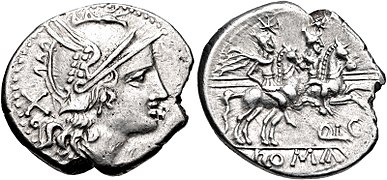
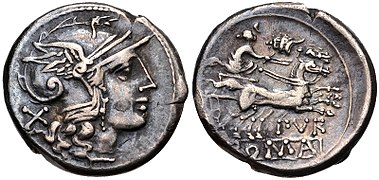


![137 BC, Ti. Veturius (Mars/Oath scene).[32]](https://upload.wikimedia.org/wikipedia/commons/thumb/5/54/Ti._Veturius%2C_denarius%2C_137_BC%2C_RRC_234-1.jpg/366px-Ti._Veturius%2C_denarius%2C_137_BC%2C_RRC_234-1.jpg)
![136 BC, C. Servilius (Roma/Pulex Geminus fighting as the Dioscuri).[33]](https://upload.wikimedia.org/wikipedia/commons/thumb/9/90/C._Servilius_M.f.%2C_denarius%2C_136_BC%2C_RRC_239-1.jpg/408px-C._Servilius_M.f.%2C_denarius%2C_136_BC%2C_RRC_239-1.jpg)



![126 BC, Gaius Cassius Longinus (Roma, voting urn behind/Libertas with pileus).[34]](https://upload.wikimedia.org/wikipedia/commons/thumb/5/52/C._Cassius_Longinus%2C_denarius%2C_126_BC%2C_RRC_266-1.jpg/383px-C._Cassius_Longinus%2C_denarius%2C_126_BC%2C_RRC_266-1.jpg)
![125 BC, C. Caecilius Metellus Caprarius (Roma/Triumph of Lucius Metellus in 251).[35]](https://upload.wikimedia.org/wikipedia/commons/thumb/7/76/C._Caecilius_Metellus_Caprarius%2C_denarius%2C_125_BC%2C_RRC_269-1.jpg/352px-C._Caecilius_Metellus_Caprarius%2C_denarius%2C_125_BC%2C_RRC_269-1.jpg)




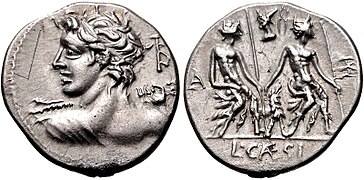

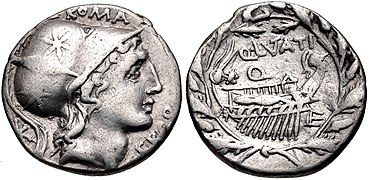


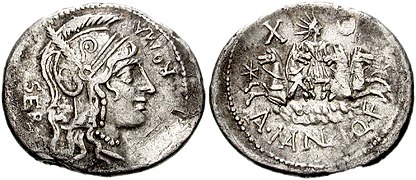
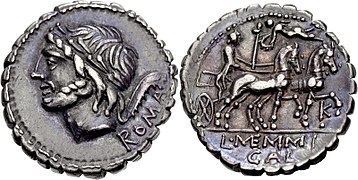

![102 BC, L. Cassius Caecianus (Ceres/yoke of Oxen).[36]](https://upload.wikimedia.org/wikipedia/commons/thumb/5/5b/L._Cassius_Caecianus%2C_denarius%2C_102_BC%2C_RRC_321-1.jpg/364px-L._Cassius_Caecianus%2C_denarius%2C_102_BC%2C_RRC_321-1.jpg)


![c.100 BC, M. Servilius (Roma/Pulex Geminus duelling).[37]](https://upload.wikimedia.org/wikipedia/commons/thumb/9/9f/M._Servilius_C.f.%2C_denarius%2C_c.100_BC%2C_RRC_327-1.jpg/360px-M._Servilius_C.f.%2C_denarius%2C_c.100_BC%2C_RRC_327-1.jpg)
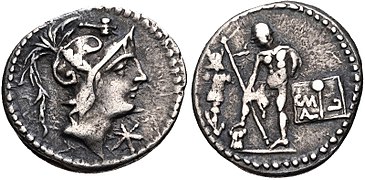






![82-80 BC, , C. Servilius Vatia (Apollo, lituus behind/Pulex Geminus fighting).[38]](https://upload.wikimedia.org/wikipedia/commons/thumb/3/30/C._Servilius_Vatia%2C_denarius%2C_82-80_BC%2C_RRC_370-1b.jpg/369px-C._Servilius_Vatia%2C_denarius%2C_82-80_BC%2C_RRC_370-1b.jpg)











![82-80 BC, , C. Servilius (Flora, lituus behind/Pulex Geminus fighting).[39]](https://upload.wikimedia.org/wikipedia/commons/thumb/9/9d/C._Servilius_C.f.%2C_denarius%2C_53_BC%2C_RRC_423-1.jpg/389px-C._Servilius_C.f.%2C_denarius%2C_53_BC%2C_RRC_423-1.jpg)
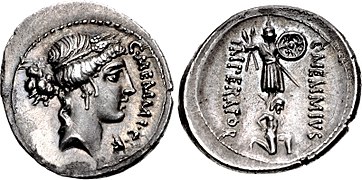
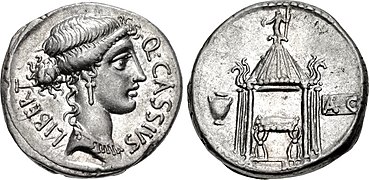

















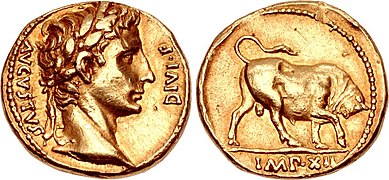


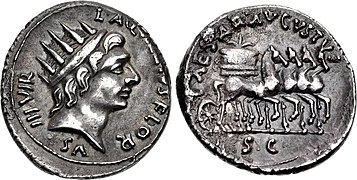

![17 BC, M. Sanquinius (Caesar, with Comet above/Herald of the Ludi Saeculares).[40]](https://upload.wikimedia.org/wikipedia/commons/thumb/8/8a/M._Sanquinius%2C_denarius%2C_17_BC%2C_RIC_I_340.jpg/381px-M._Sanquinius%2C_denarius%2C_17_BC%2C_RIC_I_340.jpg)



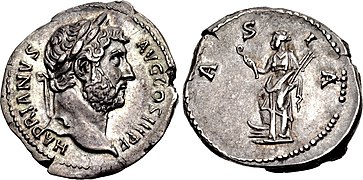


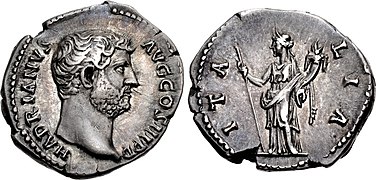
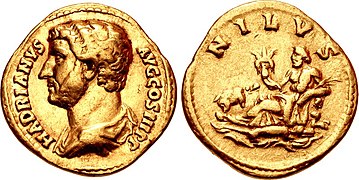
![AD 139, with Aurelius Caesar.[41]](https://upload.wikimedia.org/wikipedia/commons/thumb/2/2c/Antoninus_Pius%2C_with_Marcus_Aurelius_Caesar%2C_denarius%2C_AD_139%2C_RIC_III_412a.jpg/371px-Antoninus_Pius%2C_with_Marcus_Aurelius_Caesar%2C_denarius%2C_AD_139%2C_RIC_III_412a.jpg)
![AD 140-144, showing the betrothal of Aurelius and Faustina in 139.[42]](https://upload.wikimedia.org/wikipedia/commons/thumb/1/1b/Antoninus_Pius%2C_sestertius%2C_AD_140-144%2C_RIC_III_601.jpg/366px-Antoninus_Pius%2C_sestertius%2C_AD_140-144%2C_RIC_III_601.jpg)
![AD 166, Victoria with shield inscribed VIC PAR.[43]](https://upload.wikimedia.org/wikipedia/commons/thumb/e/ef/Marcus_Aurelius%2C_aureus%2C_AD_166%2C_RIC_III_160.jpg/379px-Marcus_Aurelius%2C_aureus%2C_AD_166%2C_RIC_III_160.jpg)
![AD 161-180, pile of German trophies.[44]](https://upload.wikimedia.org/wikipedia/commons/thumb/e/e2/Marcus_Aurelius%2C_aureus%2C_AD_161-180%2C_RIC_III_362.jpg/361px-Marcus_Aurelius%2C_aureus%2C_AD_161-180%2C_RIC_III_362.jpg)
![AD 16, medallion, Jupiter between Aurelius and Verus.[45]](https://upload.wikimedia.org/wikipedia/commons/thumb/d/d8/Marcus_Aurelius%2C_AE_medallion%2C_AD_168%2C_Gnecchi_II_52.jpg/382px-Marcus_Aurelius%2C_AE_medallion%2C_AD_168%2C_Gnecchi_II_52.jpg)
![AD 202, Septimius/Geta (right), Julia Domna (centre), Caracalla (left).[46]](https://upload.wikimedia.org/wikipedia/commons/thumb/8/8e/Septimius_Severus%2C_Julia_Domna%2C_Caracalla%2C_Geta%2C_aureus%2C_AD_202%2C_RIC_IV_181c.jpg/386px-Septimius_Severus%2C_Julia_Domna%2C_Caracalla%2C_Geta%2C_aureus%2C_AD_202%2C_RIC_IV_181c.jpg)

